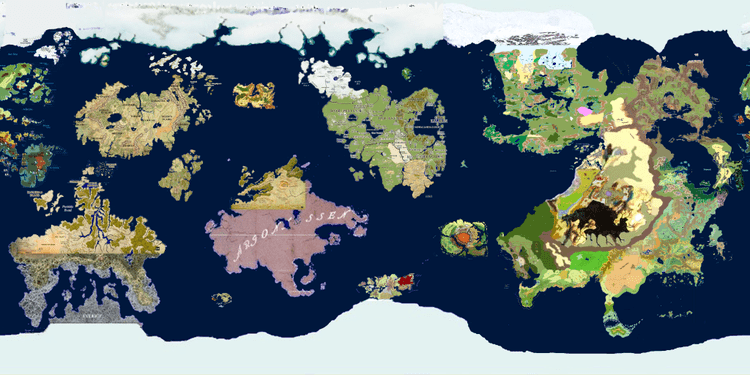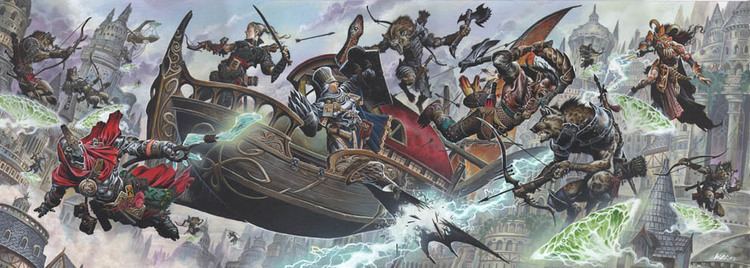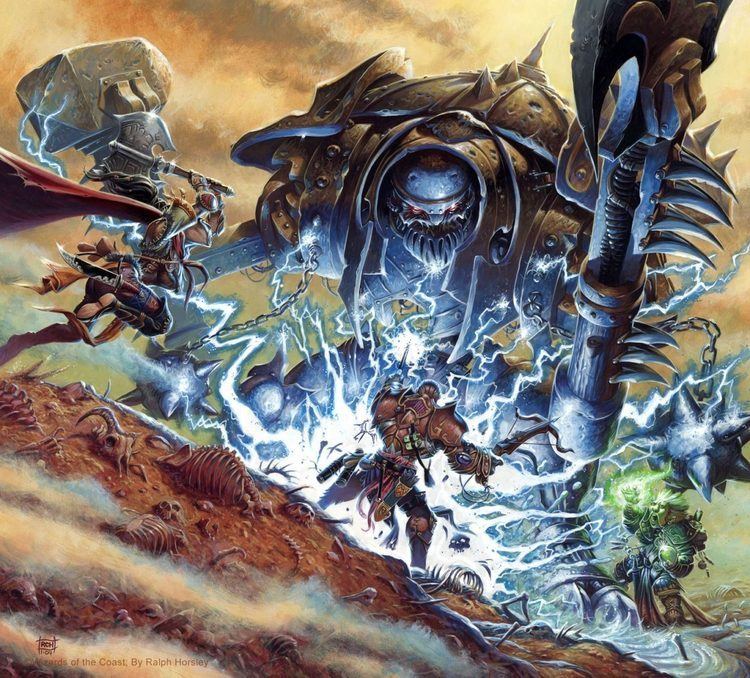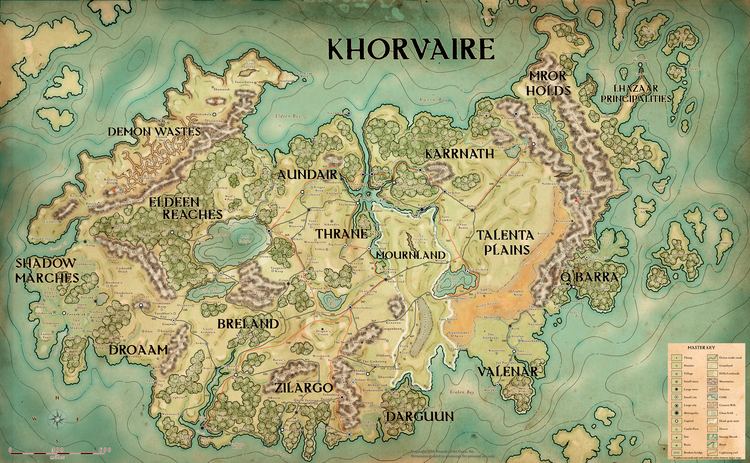 | ||
Similar Forgotten Realms, Ravenloft, Greyhawk | ||
D d campaign settings eberron in the shadow of unearthed arcana nerdarchy talks eberron
Eberron is a campaign setting for the Dungeons & Dragons (D&D) role-playing game, set in a period after a vast destructive war on the continent of Khorvaire. Eberron is designed to accommodate traditional D&D elements and races within a differently toned setting; Eberron combines a Fantasy tone with pulp and dark adventure elements, and some non-traditional fantasy technologies such as trains, skyships, and mechanical beings which are all powered by magic.
Contents
- D d campaign settings eberron in the shadow of unearthed arcana nerdarchy talks eberron
- Unearthed arcana eberron review for dungeons and dragons 5th edition
- Characteristics
- World
- Roots and influences
- References

Eberron was created by author and game designer Keith Baker as the winning entry for Wizards of the Coast's Fantasy Setting Search, a competition run in 2002 to establish a new setting for the D&D game. Eberron was chosen from more than 11,000 entries, and was officially released with the publication of the Eberron Campaign Setting hardback book in June 2004. The campaign setting book was written by Baker, Bill Slavicsek, and James Wyatt.

In June 2005, the Eberron Campaign Setting book won the Origins Award for Best Roleplaying Game Supplement of 2004.

A new version of the Campaign Setting was released in June and July 2009 to bring the setting to the new 4th edition of D&D. Released were a Player's Guide, a Campaign Guide, and an Adventure. In February 2015, an update for the 5th edition was released.
Unearthed arcana eberron review for dungeons and dragons 5th edition
Characteristics
One of the most obvious differences between Eberron and generic D&D is the level of magic. High-level magic, including resurrection spells, is less common than in most other settings. However, low-level magic is much more pervasive, primarily provided by the Dragonmarked houses. Many cities have magical lanterns throughout the streets. A continent-spanning magical "lightning rail" provides high speed transportation.
alignment is slightly more muddied than in other official settings. Evil beings of traditionally good races and good beings of traditionally evil races are encouraged; but alignment definition remains true to D&D standards, with good and evil retaining their meanings. However, the situation often arises in the campaign world that oppositely aligned characters will side with each other briefly if a threat looms over all, and also both good and evil characters will infiltrate each other's organizations for purposes of espionage.
Religion is similarly less clear-cut. The pantheon of Eberron does not make itself overtly known. The existence of divine magic is not evidence of the gods, as clerics who worship no deities but instead follow a path or belief system also receive spells. A cleric can even actively work against their own church and continue to receive spells. As a result, religion is largely a matter of faith. Unlike in many other 3rd edition D&D settings, a cleric does not have to be within one step of his deity's or religion's alignment, and is not restricted from casting certain spells because of alignment.
The setting adds a new base character class, the artificer. Artificers are spellcasters focusing on magical item creation. Artificer infusions (their equivalent to spells) focus on temporarily imbuing objects with the desired effects. For example, instead of casting bull's strength on a character, an artificer would cast it upon a belt to create a short term magical Belt of Bull's Strength. Artificers have access to a pool of "craft points" which act as extra experience points (only) for use in creating magical items without sacrificing level attainment. This pool is refilled when the artificer gains levels, or by draining power from an existing magical item (destroying the item in the process).
Eberron also introduces a new non-player character class known as the magewright, which is an arcane caster who has a limited selection of low-level spells. The existence of magewrights is part of the reason for the prevalence of low-level magic in Eberron.
To try to create a pulp setting, Eberron uses "action points" that allow a player to add a six-sided die to the result of rolls made with a twenty-sided die. Characters receive a set allotment of single-use action points each character level. The Eberron Campaign Setting also includes feats which grant additional uses for action points, such as allowing a player to add an eight-sided die instead of a six-sided die, or spending two action points to grant your character an additional move or standard action. Certain class features with uses per day, like a barbarian's rage ability, a cleric's turn/rebuke undead ability, or a druid's wild shape ability, can be used again by spending 2 action points. The final use for action points is to spend one to stabilize a dying character.
World
The world of Eberron contains 7 continents. The setting primarily takes place in Khorvaire, the most populated continent. Humans are the most populous race in Khorvaire, living primarily in the area known as the Five Nations. Southeast is the small continent of Aerenal, ruled by elves. Due south is the jungle continent of Xen'drik, once ruled by an empire of giants that collapsed. It is now largely wilderness, with some areas under tribal dominion of the drow. Further south of Xen'drik is Everice, a continent-sized sheet of ice possibly covering several land masses. Frostfell is an unexplored land of ice in the north. The other two main continents are Sarlona (a continent ruled by quori, creatures from the Region of Dreams) and Argonnessen (a continent inhabited by dragons). The world of Eberron has twelve moons; some sages believe there is a thirteenth moon that has vanished or is invisible to the naked eye.
"Eberron" is also the name for the land of the world, and is also referred to as the Dragon Between. Siberys, the Dragon Above, is the name given to the planetary rings which surround the planet. Khyber, the Dragon Below, is the name given to the underworld, and is similar to the Underdark in many other settings. According to the creation story, the world was formed when the progenitor wyrms changed their form into what they are now. Siberys and Khyber fought, leading to Siberys' body being broken into pieces. To stop Khyber, Eberron wrapped around him, and Siberys' broken body became a ring around them both. Siberys created the dragons, Eberron created humanoids and other "lower races", and Khyber created the "demons" of the world. According to Keith Baker, there is some significance to the fact that each name contains the morpheme "ber", but he has not stated what this is.
Roots and influences
The inspiration for Eberron came when Keith Baker was working on VR-1's cancelled pulp MMORPG Lost Continents. Baker aimed to fuse the energy of pulp adventure and film noir settings to traditional fantasy settings and steampunk. The Eberron Campaign Setting sourcebook lists the following movies as inspirations for Eberron's tone and attitude: Brotherhood of the Wolf, Casablanca, From Hell, The Maltese Falcon, The Mummy, The Name of the Rose, Pirates of the Caribbean, Raiders of the Lost Ark and Sleepy Hollow.
Baker said inspiration for the war-torn setting came from the unstable period of world history between World War I and World War II.
